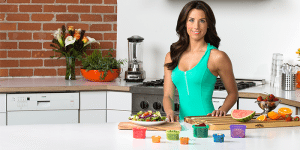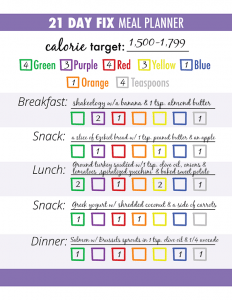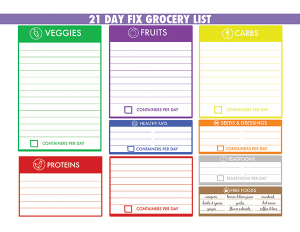21-Day Fix Meal Planning
“When it comes to being healthy and fit, it’s not just about what you do in the gym. It’s really about what you do in the kitchen.” – Autumn Calabrese.
Planning your 21-Day Fix meals may seem a bit daunting at first, especially if you’re new to healthy ingredients or portion control, but with a little practice, you will see just how easy it can be to get your clean eating on track. Below are step-by-step instructions for planning your meals and some pro tips on healthy eating.
1. Calculate Your Calorie Level and Daily Container Count
Whether you are trying to lose weight, maintain weight, or gain weight, calculating your proper daily calorie goal is essential to reaching your goals. Here’s how:
1. Multiply your current weight in pounds x 11. This number is your Caloric Baseline.
2. Add 400 (The Fix Calorie Burn) to your Caloric Baseline. The resulting number represents your Caloric Needs to maintain your weight.
3. Subtract 750 (the caloric deficit) from your Caloric Needs. This number is the Caloric Target you should eat to lose weight.
Using your 21-Day Fix Eating Plan Guide, look up the corresponding container count on page 15. Your calorie bracket will determine how many containers of each color you should eat each day.
Here’s an example using a 150-pound person who would like to lose weight.
1. 150 x 11 = 1650 (Caloric Baseline)
2. 1650 + 400 = 2050 (Caloric Needs to maintain weight)
3. 2050 – 750 = 1300 (Caloric Target to lose weight)
Note: If your Caloric Target is less than 1,200, round up to 1,200. If it’s more than 2,300, round down to 2,300. If you are trying to gain weight, add 750 instead of subtracting 750.
2. Write Down A Sample Day of Meals
Now it’s time to start planning. Go to the food lists on pages 24-39. Read through the choices and mark down some of your favorites under every container. Then, using this meal planner, plan a sample day. Think about what types of food you would like to have at each meal and include some of your favorite healthy snacks. Don’t be afraid to keep it simple.
Pro Tip: Choose most of your foods from selections near the top of the list as they are more nutritionally beneficial. Here is a sample day for the 21-Day Fix Eating Plan:
Before you move on to the next step, think about what you would like to eat for the next 3-5 days. Do you want to eat the same thing for breakfast each day, or do you want to switch it up? What about your snacks, lunches, and dinners? Do you have time to cook meals, or would you prefer to eat simply? Write down the variations you’d like, which “free foods” you’d like to add (page 37) and any treats you’d like to substitute for a yellow or orange container this week (page 38 & 39).
3. Make a Grocery List
Set yourself up for success by writing out your grocery list and sticking to it. Base your list on the foods you chose for the next 3-5 days. It’s okay to buy a surplus of these foods so that you have a little extra on hand, but try to stick to the amounts that match your calorie level. Remember that one green container holds about 1 cup or more of vegetables, and that a serving of protein is about 4 ounces (before cooking). If you plan to eat 4 red containers of boneless, skinless chicken breast over the next few days, you would buy 1 pound of chicken. Click the image below to download your Fix-friendly grocery list.
10 Time-Saving Tips
- Buy pre-cooked chicken breast or fish from the deli section.
- Choose canned tuna for quick meals.
- Buy pre-cut vegetables. (Just make sure nothing is added to it!)
- Hard-boil several eggs at once for quick, high-protein snacks or to add to salads.
- Bake all of your sweet potatoes at once.
- Pre-cook enough quinoa or brown rice for the week.
- Chop all carrots, cucumber, bell peppers, etc. at once for healthy snacks and ready toppings for salads.
- Mornings can be hectic. Have your breakfast ready to go by prepping a large batch of oatmeal.
- Stock up on berries or fruits that don’t need to be cut like apples, oranges, and bananas.
- Raw, unsalted nuts make a great, portable snack.




